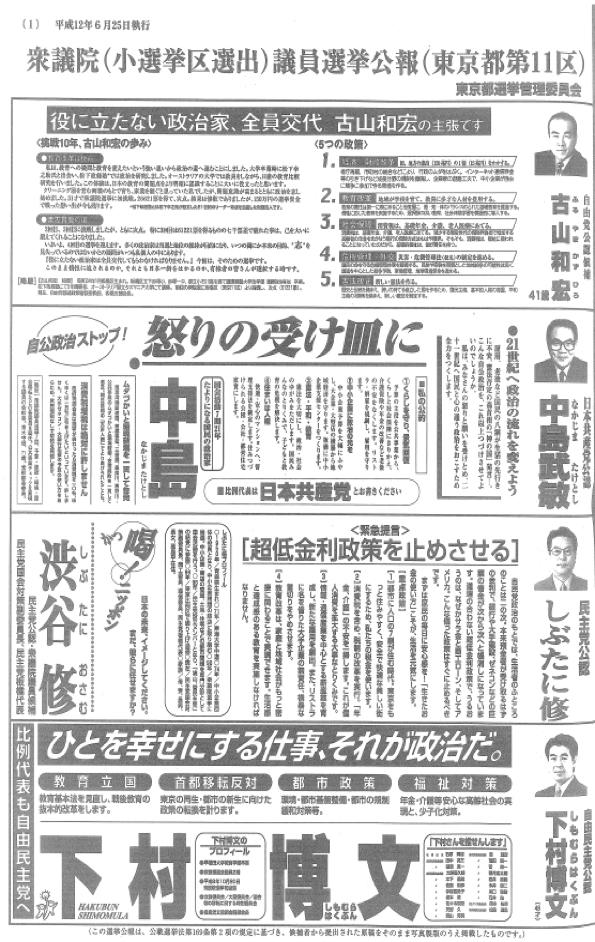Which is more important in the campaign, candidate personality or party labels?
Kyota Eguchi/Professor, Faculty of Commerce, Chuo University
Areas of Specialization: Labor Economics, applied microeconomics
There is no such thing as bad publicity.
In elections, candidates need to have their names recognized. So, in Japan, campaign cars often run around the district and call out a candidate's name on the street repeatedly. Also, early in the morning, they show some banners advertising a candidate's name at a train station and say, "This is Chuo Taro. Good morning. Have a nice day."
Many people criticize such a campaign as meaningless, but the fact that it has been going on for so many years suggests that this kind of campaign style is effective. In fact, previous studies have shown that it tends to increase the number of votes cast, though not essential to determine the winner of an election. There is no such thing as bad publicity.
However, we must be careful to estimate this effect correctly. For example, if more votes were cast in areas with more frequent campaign vehicles than in areas without, can we say that more publicity for a candidate's name increased the number of votes cast?
If you rolled a dice and randomly decided where the campaign cars would go, and if the areas where they happened to go frequently received more votes, you could say that more publicity for a candidate's name would be effective. In reality, however, it is up to the campaign headquarters to decide where and how often the campaign cars go. If they are aware that there is no point in advertising the candidate's name in areas where there are few supporters, they will not be in those areas. In the first place, they will not go where there are few people. If you go where it works, where there are more people, then it is natural that you will get more votes, and it will no longer be the result of name promotion.
Which matters, candidates or parties?
It is a common practice for campaign vehicles to drive around the district. But, of course, there is no such data on how many times candidates' names are shouted on the streets during the election period. Therefore, I turned to the campaign bulletins, senkyo-koho. Figure 1 shows the campaign bulletin for Tokyo's 11th district in the 2000 House of Representatives election, and you can tell that each candidate had his name displayed in large letters. As with calling candidates' names from campaign cars, large name displays are probably extremely important to candidates for name recognition, even though there is less space left to write about their accomplishments and promises.

Figure 1
Figure 2 is the campaign bulletin of Hirofumi Shimomura, a candidate in the 2003 Lower House election (Tokyo 11th district). His own name and party affiliation, the Liberal Democratic Party (LDP), are repeated and prominently displayed. Looking at Shimomura's ad, we can see that there is an old and new problem in political science: which is more important in an election, the characteristics of the candidate or the parties he or she belongs to?

Figure 2
Of course, individual candidates are important when voting in elections, but many voters consider partisanship important, voting for a candidate because he or she is a candidate of the LDP even though they do not know the candidate well, or conversely, voting for the best candidate of the opposition party because they never want to vote just for the LDP.
If voters vote for or against a candidate based on the candidate's individual characteristics, the candidate will respond accordingly. If voters focus on the candidate's individual characteristics and accomplishments, the candidate will primarily promote his or her name and accomplishments. Conversely, if voters focus on the political party to which they belong, the candidate will also primarily appeal to the party's manifestos and leaders.
Which is more important, the candidate personality or his or her party affiliation?
The answer depends on the electoral system.
As a result of the 1994 reform of Japan's House of Representatives election system, the system was changed from a multi-member district (MMD) system to a single-member district (SMD) one. In the SMD system, a district has a single seat. On the other hand, if a district has more than one seat, it is called a MMD system. Municipal Assembly elections in Japan are an example of a MMD system, where nearly 30 seats are given to a single district. On the other hand, comparatively smaller MMDs with three to five seats are called "middle-size districts" in Japan for convenience. Japan's "middle-size district" system is defined as a single non-transferable vote (SNTV) and MMD system. From the postwar period until the 1993 election, elections to the House of Representatives in Japan were held under the SNTV-MMD system with about 130 MMDs.
Under this SNTV-MMD system, the party seeking a majority must field more than one candidate in the MMDs in order to take power and win a majority of seats in parliament. In fact, the LDP, the long-ruling party in Japan, ran more than one candidate in a single district. Opposition parties also sometimes ran more than one candidate in some districts.
When more than one candidate runs in a single district, their party label becomes less attractive. Even if a candidate ran as "Suzuki of the LDP," there would still be Sato and Tanaka from the same LDP. In competition with rival candidates from the same LDP, the advantage of the LDP label becomes smaller. As a result, each candidate appealed to his or her personal achievements and promises, organized support groups, and developed ties with the local community.
However, the situation changed drastically with the introduction of the SMD system. Since there is only one seat in the House of Representatives, parties can only officially recognize one candidate. Since there could be only one candidate from the LDP, the power of the party headquarters, which had the authority to grant official recognition, was strengthened. Elections of party against party are more common, and the party leader's leadership came to be seen as important.
Estimation method: difference-in-differences estimation
Thus, it is said that the reform of the electoral system toward the SMD system has changed the political situation in Japan from a candidate-oriented campaign to a party-oriented one. This in itself may be true. However, much of this is merely impressionistic, and as far as I know, no one has presented proper evidence to support it.
If this is the case, then the promotion in the election bulletins should have changed as well: the SNTV-MMD system would be expected to show the candidate's name in a larger font, while the SMD system would show the party label in a larger font.
However, an appropriate method is needed to confirm the above hypothesis. The way candidates present themselves in the campaign bulletin has changed from the past. Now it is easy to design and edit the campaign bulletin on the computer, but in the past it was difficult. Nowadays, it is not unusual to use illustrations of candidates, but this was not possible in the Showa period. The before and after of the House of Representatives election is a mixture of the effects of these changes in time as well as the differences in the electoral system.
Therefore, I used the House of Councilors election. Since the House of Councilors election in Tokyo remained unchanged: the SNTV-MMD system has been used, the before and after for the House of Councilors only includes the changes over time. By looking at the difference between the before-and-after results for the House of Councilors and those for the House of Representatives, we can expect to be able to properly estimate the genuine effect of the electoral system for the House of Representatives. This method, called difference-in-differences estimation, is one of the most widely used estimation methods in the social sciences, and researchers who made significant contributions to the development and application of this estimation method were awarded the Nobel Prize in Economics last year.
In fact, in my research analyzing Tokyo electoral districts for both House of Representatives and House of Councilors elections from 1983 to 2014, I statistically showed that the size of candidate names became smaller and the size of party labels became larger in the House of Representatives after the SMD system was introduced. The electoral reform based on the SMD system has changed the political situation in Japan. However, the LDP candidates tended to promote their candidate names in larger letters than the opposition party candidates, suggesting that campaigning dependent on supporters' associations remained strong, especially for the LDP candidates.
Elections and politics in Japan seem to have changed or not at first glance. Words are cheap. Science is the process of formulating hypotheses and verifying what is said only in words, and in many fields of social science, mathematical theoretical models and data-based analysis will make further progress.
Kyota Eguchi/Professor, Faculty of Commerce, Chuo University
Areas of Specialization: Labor Economics, applied microeconomicsThe author was born in Osaka in 1968.
He graduated from the undergraduate school of Economics, the University of Tokyo in 1992, and received a Ph.D. in economics from the University of Tokyo in 2000. After serving as a research associate at the University of Tokyo, an associate professor at the Division of Policy and Planning Sciences, University of Tsukuba, and a visiting researcher at the University of Essex in UK, he has served at his current position since 2013.His books include “Otona ninatte Yomu Keizaigaku no Kyokasyo” (Economics for Adult Learners) (Minervashobo, 2015, sole author); “Kyaria Risuku no Keizaigaku” (Human resource management) (Seisansei Shuppan, 2010, sole author); “Kaiko Kisei no Ho to Keizai” (Employment Protection Legislation and Economy in Japan) (Nippon Hyoron Sha, 2008, joint author),.
His papers include “Trainers’ Dilemma of Choosing between Training and Promotion,” Labour Economics, vol. 11 (2004), 765-783; “Job Transfer and Influence Activities,” Journal of Economic Behavior and Organization, vol.56 (2005), 187-197; “Employment Protection Legislation and Cooperation,” Labour, vol.32 (2018), 45-73.









